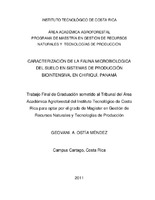Mostrar el registro sencillo del ítem
Caracterización de la fauna microbiológica del suelo en sistemas de producción biointensiva, en Chiriquí, Panamá
| dc.contributor.advisor | Villalba-Velásquez, Vladimir | es |
| dc.contributor.author | Ostía-Méndez, Geovani | |
| dc.date.accessioned | 2015-10-08T20:30:30Z | |
| dc.date.available | 2015-10-08T20:30:30Z | |
| dc.date.issued | 2011 | |
| dc.identifier.uri | https://hdl.handle.net/2238/6302 | |
| dc.description | Proyecto de Graduación (Maestría en Gestión de Recursos Naturales y Tecnologías de Producción) Instituto Tecnológico de Costa Rica, Área Académica Agroforestal, 2011. | es |
| dc.description.abstract | Knowing the soil as a complex system, active and its application to design efficient to curb degradation and recover from adversity to produce and keep in unstable environments, can only be tackled comprehensively by models agroecological management agricultural models . One of these agro-ecological models, almost 99% efficient or sustainable, is the method of bio-intensive farming culture incorporating experiences accumulated by humanity about 4000 years (Torres and Martinez, 2010) ago. Biointensive is a sustainable system focused on growing more food in a small space but also improve soil, based on the use and incorporation of organic matter and agronomic strategies like crop rotation and association, among others, that leverages qualities of certain plants to repel some pests of crops and local inputs such as compost, green manures, compost and plant residues (Semarnat, 2010). Where reference is made to waste plants and animals of all types, in different stages of decomposition, there is talk of organic matter (Jeavons, 2002). These residues are composed of complex molecules (sugars, starches, proteins, oils, waxes, etc.) through macrobiota activity, and soil microbiota mesobiota decompose into inorganic substances available to the plant as phosphates, sulfates, Nitrates, potassium and other micronutrients. (Sanchez and Gomez, 2001). However, the issue of bio-intensive method of cultivation or other sustainable agricultural production system occurs when soil produces crops, as the plants extract nutrients that are lost, so is the organic matter and humus consumed by microorganisms . So for 2 maintain soil organic matter longer should replenish biological resources as activators of soil fertility (Jeavons, 2002). This study aims to make a microbiological evaluation at different soil depths in bio-intensive gardens that are being developed in the province of Chiriqui, Panama. It also seeks to quantify and relate the microbial fauna in the sustainability of bio-intensive organic matter in soil gardens. The importance of this research lies in observing the diversity of beneficial microorganisms at ground level of these gardens and relate to the percentage of organic matter found and the different types of compost applied to analyze the maintenance of it on the ground. With this study important information which will help to develop strategies to optimize the productivity and health of crops and bio-intensive conservation and soil improvement is obtained. | es |
| dc.description.sponsorship | Instituto Tecnológico de Costa Rica. Área Académica Agroforestal. Programa de Maestría en Gestión de Recursos Naturales y Tecnologías de Producción | es |
| dc.language.iso | es | es |
| dc.publisher | Instituto Tecnológico de Costa Rica | es |
| dc.rights | acceso abierto | es |
| dc.subject | Almácigo | es |
| dc.subject | Siembra | es |
| dc.subject | Cultivos | es |
| dc.subject | Huertos | es |
| dc.subject | Semillas | es |
| dc.subject | Materia orgánica | es |
| dc.title | Caracterización de la fauna microbiológica del suelo en sistemas de producción biointensiva, en Chiriquí, Panamá | es |
| dc.type | tesis de maestría | es |


